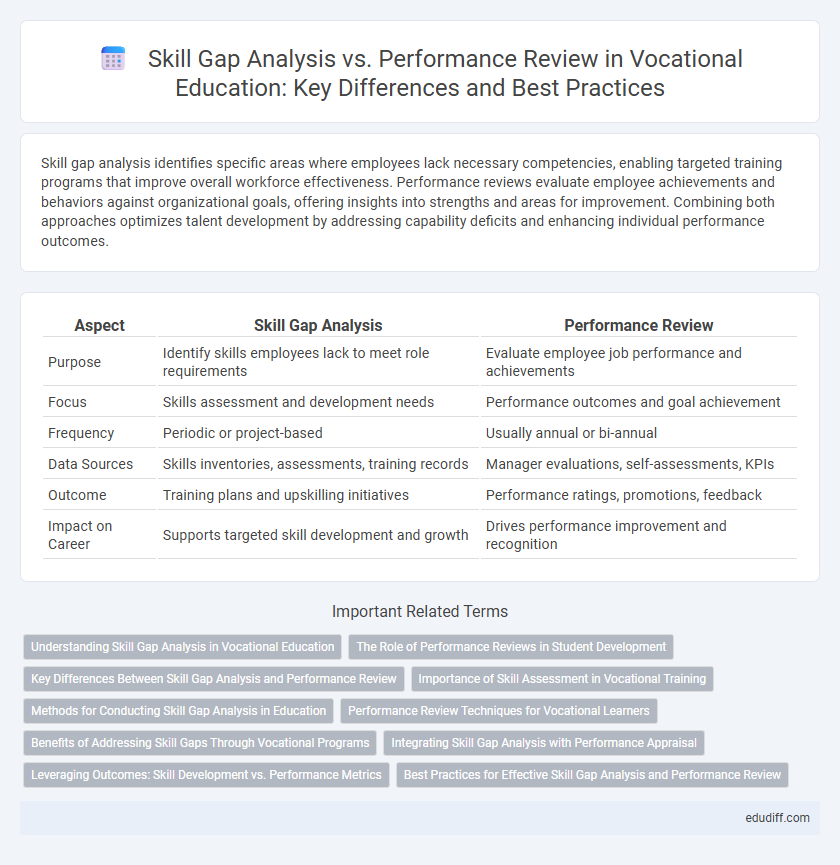Skill gap analysis identifies specific areas where employees lack necessary competencies, enabling targeted training programs that improve overall workforce effectiveness. Performance reviews evaluate employee achievements and behaviors against organizational goals, offering insights into strengths and areas for improvement. Combining both approaches optimizes talent development by addressing capability deficits and enhancing individual performance outcomes.
Table of Comparison
| Aspect | Skill Gap Analysis | Performance Review |
|---|---|---|
| Purpose | Identify skills employees lack to meet role requirements | Evaluate employee job performance and achievements |
| Focus | Skills assessment and development needs | Performance outcomes and goal achievement |
| Frequency | Periodic or project-based | Usually annual or bi-annual |
| Data Sources | Skills inventories, assessments, training records | Manager evaluations, self-assessments, KPIs |
| Outcome | Training plans and upskilling initiatives | Performance ratings, promotions, feedback |
| Impact on Career | Supports targeted skill development and growth | Drives performance improvement and recognition |
Understanding Skill Gap Analysis in Vocational Education
Skill gap analysis in vocational education identifies specific competencies learners lack to meet industry standards, guiding targeted training programs. Performance review measures an individual's current job performance but may not fully reveal underlying skill deficiencies critical for vocational advancement. Understanding skill gap analysis enables educators to develop curriculum tailored to closing these gaps, enhancing employability and workforce readiness.
The Role of Performance Reviews in Student Development
Performance reviews play a crucial role in student development by providing targeted feedback that identifies strengths and areas for improvement, which helps bridge the skill gap between academic learning and practical application. While skill gap analysis focuses on identifying specific competencies lacking in students, performance reviews offer a dynamic assessment of ongoing progress and practical skill enhancement. This iterative evaluation process supports personalized learning paths, fostering continuous growth and readiness for vocational challenges.
Key Differences Between Skill Gap Analysis and Performance Review
Skill gap analysis identifies specific competencies employees lack relative to job requirements, targeting training needs for workforce development. Performance reviews evaluate overall employee effectiveness and achievements based on set goals and past performance metrics. While skill gap analysis focuses on future skill enhancement, performance reviews assess current job performance and productivity.
Importance of Skill Assessment in Vocational Training
Skill gap analysis identifies the specific competencies learners lack, enabling targeted vocational training that aligns with industry standards and job requirements. Performance reviews primarily evaluate overall job effectiveness but may overlook underlying skill deficiencies critical for career development. Prioritizing skill assessments in vocational training ensures precise identification of learner needs, fostering enhanced employability and reduced skill mismatches in the workforce.
Methods for Conducting Skill Gap Analysis in Education
Skill gap analysis in education employs methods such as competency mapping, where educators identify specific skills required for job roles and compare them with current student capabilities to highlight deficiencies. Surveys and assessments, including quizzes and practical tests, provide quantitative data on student skill levels, facilitating targeted curriculum adjustments. Observations and feedback from instructors during classes also contribute qualitative insights, enabling personalized learning plans that bridge skill gaps effectively.
Performance Review Techniques for Vocational Learners
Performance review techniques for vocational learners emphasize practical assessments, hands-on demonstrations, and real-time feedback to measure skill application and competency effectively. Unlike skill gap analysis, which identifies missing skills through evaluations and tests, performance reviews focus on ongoing observation and coaching during actual vocational tasks to enhance learning outcomes. Utilizing video recordings, peer reviews, and competency checklists enriches the accuracy and relevance of performance evaluations in vocational training environments.
Benefits of Addressing Skill Gaps Through Vocational Programs
Addressing skill gaps through vocational programs enhances employee competencies by providing targeted training aligned with industry demands, resulting in improved productivity and job performance. Unlike performance reviews that primarily evaluate past behaviors, skill gap analysis identifies specific developmental needs, enabling organizations to implement tailored vocational interventions that foster career growth and adaptability. This proactive approach reduces turnover rates and supports workforce readiness in rapidly evolving job markets, ensuring long-term organizational success.
Integrating Skill Gap Analysis with Performance Appraisal
Integrating skill gap analysis with performance appraisal provides a comprehensive approach to employee development by identifying specific areas where skills do not meet job requirements. This fusion enables targeted training programs that directly address deficiencies highlighted during performance reviews, enhancing overall workforce competency. Organizations leveraging this integration achieve improved talent management, aligning individual capabilities with strategic business goals.
Leveraging Outcomes: Skill Development vs. Performance Metrics
Skill gap analysis identifies specific areas where employees require development to meet job demands, emphasizing targeted skill enhancement. Performance reviews assess overall job effectiveness through metrics like productivity and goal achievement, focusing on past and current outcomes. Leveraging both outcomes supports comprehensive talent management by aligning skill development with measurable performance improvements.
Best Practices for Effective Skill Gap Analysis and Performance Review
Effective skill gap analysis requires a systematic assessment of current employee competencies against job requirements, using tools like competency matrices and employee self-assessments to identify specific areas for development. Performance reviews should incorporate continuous feedback, clear goal setting, and measurable performance metrics to align individual progress with organizational objectives. Integrating both processes by regularly updating skill inventories and tailoring development plans ensures workforce capability growth and enhances overall productivity.
Skill gap analysis vs Performance review Infographic

 edudiff.com
edudiff.com